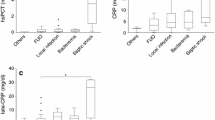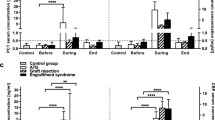Abstract
Purpose
Serum procalcitonin (PCT) has become a routinely utilized parameter with a high prediction value of the severity of bacterial infectious complications and their immediate outcomes. Whereas the utility of PCT in differentiating between bacterial and viral infection is generally accepted, its significance in fungal infections has yet to be determined. The aim of the study was to determine the role of PCT testing in patients at high risk for invasive fungal infections.
Methods
Immunocompromised hematological patients undergoing cyclic chemotherapy treatment or allogeneic hemopoietic stem cell transplantation with infectious complications in which the infectious agents were identified during the disease course were evaluated. In patients with bacterial infection, positive hemocultures were documented, and in patients with fungal infection, the presence of either proven or probable disease was confirmed according to Ascioglu criteria. C-reactive protein (CRP) and PCT were prospectively assessed from the day following fever onset, for four consecutive days.
Results
Overall, 34 patients were evaluated, 21 with bacterial and 13 with fungal infections. Significant elevations of CRP concentrations (i.e., above the upper normal limit) were observed in all patients, with a tendency toward higher levels in bacterial (both gram-positive [Gr+] and Gr-negative [Gr−]) than in fungal infections. PCT levels were significantly elevated in patients with bacterial infections (e.g., predominantly in Gr− compared to Gr+), whereas in patients with fungal infections, we identified minimal or no PCT elevations, p < 0.01. For the fungal infections, according to constructed receiver operating characteristic curves, a combination of PCT <0.5 μg/L and CRP 100–300 mg/L offers the best specificity, sensitivity and positive and negative predictive values (81, 85, 73, and 89 %, respectively).
Conclusion
Altogether, our data suggest that the finding of substantially elevated CRP combined with low PCT in immunocompromised patients may indicate systemic fungal infection. The use of this combination might simplify the diagnostic process, which otherwise can often be lengthy and arduous.


Similar content being viewed by others
Abbreviations
- PCT:
-
Procalcitonin
- CRP:
-
C-reactive protein
- GvHD:
-
Graft-versus-host disease
- Gr+:
-
Gram positive
- Gr−:
-
Gram negative
References
Ascioglu S, Rex JH, de Pauw B, Bennett JE, Bille J, Crokaert F, Denning DW, Donnelly JP, Edwards JE, Erjavec Z, Fiere D, Lortholary O, Maertens J, Meis JF, Patterson TF, Ritter J, Selleslag D, Shah PM, Stevens DA, Walsh TJ, Invasive Fungal Infections Cooperative Group of the European Organization for Research and Treatment of Cancer, Mycoses Study Group of the National Institute of Allergy and Infectious Diseases (2002) Defining opportunistic invasive fungal infections in immunocompromised patients with cancer and hematopoietic stem cell transplants: an international consensus. Clin Infect Dis 34(1):7–14
Pfaller MA, Diekema DJ, Andes D, Arendrup MC, Brown SD, Lockhart SR, Motyl M, Perlin DS, the CLSI Subcommittee for Antifungal Testing (2011) Clinical breakpoints for the echinocandins and Candida revisited: integration of molecular, clinical, and microbiological data to arrive at species-specific interpretive criteria. Drug Resist Updat(Feb 23)
Denning DW, Park S, Lass-Florl C, Fraczek MG, Kirwan M, Gore R, Smith J, Bueid A, Moore CB, Bowyer P, Perlin DS (2011) High-frequency triazole resistance found in nonculturable Aspergillus fumigatus from lungs of patients with chronic fungal disease. Clin Infect Dis 52(9):1123–1129
Howard SJ, Arendrup MC (2011) Acquired antifungal drug resistance in Aspergillus fumigatus: epidemiology and detection. Med Mycol 49(Suppl 1):S90–S95
Marr KA, Balajee SA, McLaughlin L, Tabouret M, Bentsen C, Walsh TJ (2004) Detection of galactomannan antigenemia by enzyme immunoassay for the diagnosis of invasive aspergillosis: variables that affect performance. J Infect Dis 190(3):641–649
Maertens J, Buvé K, Theunissen K, Meersseman W, Verbeken E, Verhoef G, Van Eldere J, Lagrou K (2009) Galactomannan serves as a surrogate endpoint for outcome of pulmonary invasive aspergillosis in neutropenic hematology patients. Cancer 115(2):355–362
Hope WW, Kruhlak MJ, Lyman CA, Petraitiene R, Petraitis V, Francesconi A, Kasai M, Mickiene D, Sein T, Peter J, Kelaher AM, Hughes JE, Cotton MP, Cotten CJ, Bacher J, Tripathi S, Bermudez L, Maugel TK, Zerfas PM, Wingard JR, Drusano GL, Walsh TJ (2007) Pathogenesis of Aspergillus fumigatus and the kinetics of galactomannan in an in vitro model of early invasive pulmonary aspergillosis: implications for antifungal therapy. J Infect Dis 195(3):455–466
Becker MJ, de Marie S, Willemse D, Verbrugh HA, Bakker-Woudenberg IA (2000) Quantitative galactomannan detection is superior to PCR in diagnosing and monitoring invasive pulmonary aspergillosis in an experimental rat model. J Clin Microbiol 38(4):1434–1438
Buchheidt D, Hummel M (2005) Aspergillus polymerase chain reaction (PCR) diagnosis. Med Mycol 43(Suppl 1):S139–S145
Khot PD, Ko DL, Hackman RC, Fredricks DN (2008) Development and optimization of quantitative PCR for the diagnosis of invasive aspergillosis with bronchoalveolar lavage fluid. BMC Infect Dis 8:73
Vincent JL, Donatelo K, Schmidt X (2011) Biomarkers in the critically ill patient: C-reactive protein. Crit Care Clin 27:241–251
Reinhard K, Meisner M (2011) Biomarkers in the critically ill patient: procalcitonin. Crit Care Clin 27:253–263
Ortega M, Rovira M, Filella X, Almela M, Puig de la Bellacasa J, Carreras E, Mensa J (2004) Prospective evaluation of procalcitonin in adults with febrile neutropenia after haematopoietic stem cell transplantation. Br J Haematol 126(3):372–376
Christofilopoulou S, Charvalos E, Petrikkos G (2002) Could procalcitonin be a predictive biological marker in systemic fungal infections? Study of 14 cases. Eur J Intern Med 13(8):493–495
Petrikkos GL, Christofilopoulou SA, Tentolouris NK, Charvalos EA, Kosmidis CJ, Daikos GL (2005) Value of measuring serum procalcitonin, C-reactive protein, and mannan antigens to distinguish fungal from bacterial infections. Eur J Clin Microbiol Infect Dis 24(4):272–275
Charles PE, Dalle F, Aho S, Quenot JP, Doise JM, Aube H, Olsson NO, Blettery B (2006) Serum procalcitonin measurement contribution to the early diagnosis of candidemia in critically ill patients. Intensive Care Med 32(10):1577–1583
Hambach L, Eder M, Dammann E, Schrauder A, Sykora KW, Dieterich C, Kirschner P, Novotny J, Ganser A, Hertenstein B (2002) Diagnostic value of procalcitonin serum levels in comparison with C-reactive protein in allogeneic stem cell transplantation. Haematologica 87(6):643–651
Gérard Y, Hober D, Petitjean S, Assicot M, Bohuon C, Mouton Y, Wattré P (1995) High serum procalcitonin level in a 4-year-old liver transplant recipient with a disseminated candidiasis. Infection 23(5):310–311
Beaune G, Bienvenu F, Pondarré C, Monneret G, Bienvenu J, Souillet G (1998) Serum procalcitonin rise is only slight in two cases of disseminated aspergillosis. Infection 26(3):168–169
Halekoh U, Højsgaard S, Yan J (2006) The R package geepack for generalized estimating equations. J Stat Softw 15(2):1–11
Siegel S, Castellan NJ (1988) Nonparametric statistics for the behavioral sciences, 2nd edn. McGraw-Hill, New York
Blijlevens NM, Donnelly JP, Meis JF, De Keizer MH, De Pauw BE (2000) Procalcitonin does not discriminate infection from inflammation after allogeneic bone marrow transplantation. Clin Diagn Lab Immunol 7(6):889–892
Dornbusch HJ, Strenger V, Kerbl R, Lackner H, Schwinger W, Sovinz P, Urban C (2005) Procalcitonin—a marker of invasive fungal infection? Support Care Cancer 13(5):343–346
Martini A, Gottin L, Menestrina N, Schweiger V, Simion D, Vincent JL (2010) Procalcitonin levels in surgical patients at risk of candidemia. J Infect 60(6):425–430
Montagna MT, Coretti C, Caggiano G (2011) Procalcitonin: a possible marker of invasive fungal infection in high risk patients? J Prev Med Hyg 52(1):38–39
Charles PE, Tinel C, Barbar S, Aho S, Prin S, Doise JM, Olsson NO, Blettery B, Quenot JP (2009) Procalcitonin kinetics within the first days of sepsis: relationship with the appropriateness of antibiotic therapy and the outcome. Crit Care 13(2):R38
Suberviola B, Castellanos-Ortega A, González-Castro A, García-Astudillo LA, Fernández-Miret B (2012) Prognostic value of procalcitonin, C-reactive protein and leukocytes in septic shock. Med Intensiva 36(3):177–184
Simon L, Gauvin F, Saint Louis P, Lacroix J (2004) Serum procalcitonin and C-reactive levels as markers of bacterial infection: a systematic review and meta-analysis. Clin Infect Dis 39:206–217
Assicot M, Gendrel D, Carsin H, Raymond J, Guilbaud J, Bohuon C (1993) High serum procalcitonin concentrations in patients with sepsis and infection. Lancet 341(8844):515–518
Becker KL, Snider R, Nylen ES (2008) Procalcitonin assay in systemic inflammation, infection, and sepsis: clinical utility and limitations. Crit Care Med 36(3):941–952
Schuetz P, Christ-Crain M, Müller B (2007) Biomarkers to improve diagnostic and prognostic accuracy in systemic infections. Curr Opin Crit Care 13(5):578–585
Schuetz P, Christ-Crain M, Thomann R, Falconnier C, Wolbers M, Widmer I, Neidert S, Fricker T, Blum C, Schild U, Regez K, Schoenenberger R, Henzen C, Bregenzer T, Hoess C, Krause M, Bucher HC, Zimmerli W, Mueller B, ProHOSP Study Group (2009) Effect of procalcitonin-based guidelines vs standard guidelines on antibiotic use in lower respiratory tract infections: the ProHOSP randomized controlled trial. JAMA 302(10):1059–1066
Tang H, Huang T, Jing J, Shen H, Cui W (2009) Effect of procalcitonin-guided treatment in patients with infections: a systematic review and meta-analysis. Infection 37(6):497–507
Bucova M, Zahorec R, Buc M (2006) Immunomodulatory effect of recombinant human procalcitonin on mitogenic activity of lymphocytes. Cent Eur J Immunol 31(3–4):87–93
Wei JX, Verity A, Garle M, Mahajan R, Wilson V (2008) Examination of the effect of procalcitonin on human leucocytes and the porcine isolated coronary artery. Br J Anaesth 100(5):612–621
Liappis AP, Gibbs KW, Nylen ES, Yoon B, Snider RH, Gao B, Becker KL (2011) Exogenous procalcitonin evokes a pro-inflammatory cytokine response. Inflamm Res 60(2):203–207
Hoffmann G, Czechowski M, Schloesser M, Schobersberger W (2002) Procalcitonin amplifies inducible nitric oxide synthase gene expression and nitric oxide production in vascular smooth muscle cells. Crit Care Med 30(9):2091–2095
Becker KL, Nylén ES, Snider RH, Müller B, White JC (2003) Immunoneutralization of procalcitonin as therapy of sepsis. J Endotoxin Res 9(6):367–374
Acknowledgements
Supported by research project RVO-VFN64165 and Czech Republic Ministry of Health project for conceptual development of research organization (NT 13899).
Competing interests
The authors declare that they have no competing interests
Authors’ contributions
MM designed the study, made the patients collection and diagnosis final determination, and drafted the manuscript, HB carried out biochemical testing, KM performed the statistical analysis and participated in the design of the study, VV and PC helped with the patients diagnosing and collection, MK helped with diagnosis etiology standing, MH participated in the study coordination and manuscript writing. All authors read and approved the final manuscript.
Author information
Authors and Affiliations
Corresponding author
Appendix 1
Appendix 1
Definitions of invasive fungal infections in patients with cancer and recipients of hematopoietic stem cell transplants
Adopted from Ascioglu S et al., Clin Infect Dis. 2002 Jan 1;34(1):7– 14.
Rights and permissions
About this article
Cite this article
Marková, M., Brodská, H., Malíčková, K. et al. Substantially elevated C-reactive protein (CRP), together with low levels of procalcitonin (PCT), contributes to diagnosis of fungal infection in immunocompromised patients. Support Care Cancer 21, 2733–2742 (2013). https://doi.org/10.1007/s00520-013-1844-1
Received:
Accepted:
Published:
Issue Date:
DOI: https://doi.org/10.1007/s00520-013-1844-1




